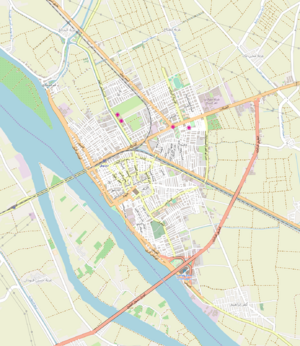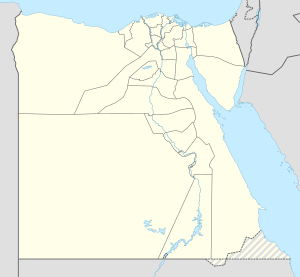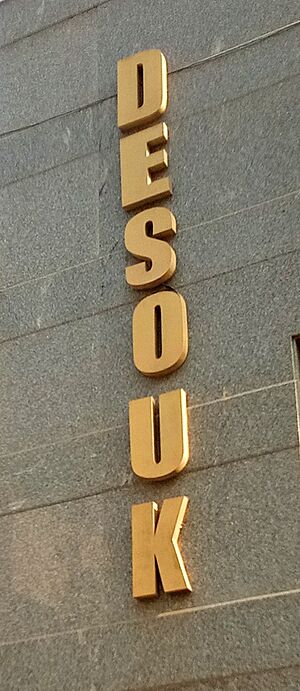Desouk facts for kids
Quick facts for kids
Desouk
دسوق
|
|
|---|---|

Clockwise, from top: Desouk Bridge, Ibrahim El Desouki Mosque, City Hall, Nile in Desouk, a statue of Ramesses II with Goddess Sekhmet, Desouk War Memorial, New Desouk Bridge.
|
|

Map of Desouk
|
|
| Country | |
| Governorate | Kafr El Sheikh |
| Area | |
| • Total | 8.635 km2 (3.334 sq mi) |
| Elevation | 0 m (0 ft) |
| Population
(2021)
|
|
| • Total | 149,291 |
| • Density | 17,289.1/km2 (44,778.4/sq mi) |
| Time zone | UTC+2 (EST) |
| ZIP code |
33611 – 33612
|
| Area code(s) | +2 047 |
Desouk (pronounced Dis-SOOK) is an important city in northern Egypt. It's about 80 kilometers (50 miles) east of Alexandria. Desouk is part of the Kafr El Sheikh Governorate. In 2011, about 137,660 people lived there. The city is next to the Beheira Governorate on its west side.
Desouk has a very long history. It dates back to at least 3200 BC. It was once part of the ancient city of Buto. This was before Upper and Lower Egypt became one country. From 1250 to 1517, Desouk was part of the Gharbia province. Later, from 1798 to 1801, it was part of the Rosetta province.
Contents
What's in a Name?
The name "Desouk" might come from ancient Egyptian words. One idea is that it means "land of Sobek". Sobek was an ancient Egyptian god with a crocodile head. This name was found on an old statue.
Another idea is that it comes from an Arabic word. This word means "to overflow" or "a basin full of water". However, this idea is not as likely.
Desouk at a Glance
Desouk is a special city because it has important Islamic holy sites. It is even a member of the Organization of Islamic Capitals and Cities. One of the most important sites is the tomb of Ibrahim El Desouki. He was a famous Egyptian Sufi saint. His tomb is inside the main mosque in the city center.
The city is located on the eastern bank of the Rosetta branch of the Nile River. Only two bridges connect the city across the river.
Many famous Egyptians come from Desouk. These include the scientist Ahmed Zewail and the singer Mohammed Roshdy.
Weather in Desouk
Desouk has a hot desert climate. This is similar to most of Egypt. It means the weather is usually hot and dry.
| Climate data for Desouk | |||||||||||||
|---|---|---|---|---|---|---|---|---|---|---|---|---|---|
| Month | Jan | Feb | Mar | Apr | May | Jun | Jul | Aug | Sep | Oct | Nov | Dec | Year |
| Mean daily maximum °C (°F) | 17.8 (64.0) |
18.8 (65.8) |
21.5 (70.7) |
25.3 (77.5) |
29.2 (84.6) |
30.9 (87.6) |
32.2 (90.0) |
32.3 (90.1) |
30.6 (87.1) |
28.8 (83.8) |
24.6 (76.3) |
19.9 (67.8) |
26.0 (78.8) |
| Daily mean °C (°F) | 12.4 (54.3) |
13.1 (55.6) |
15.4 (59.7) |
18.6 (65.5) |
22.3 (72.1) |
24.6 (76.3) |
26.1 (79.0) |
26.2 (79.2) |
24.7 (76.5) |
22.8 (73.0) |
19.1 (66.4) |
14.5 (58.1) |
20.0 (68.0) |
| Mean daily minimum °C (°F) | 7 (45) |
7.4 (45.3) |
9.3 (48.7) |
11.9 (53.4) |
15.4 (59.7) |
18.4 (65.1) |
20.1 (68.2) |
20.2 (68.4) |
18.8 (65.8) |
16.8 (62.2) |
13.6 (56.5) |
9.1 (48.4) |
14.0 (57.2) |
| Average precipitation mm (inches) | 26 (1.0) |
20 (0.8) |
9 (0.4) |
4 (0.2) |
3 (0.1) |
0 (0) |
0 (0) |
0 (0) |
0 (0) |
6 (0.2) |
13 (0.5) |
23 (0.9) |
104 (4.1) |
| Source: Climate-Data.org | |||||||||||||
Visiting Desouk
Desouk is a popular place for visitors, especially because of the Ibrahim El Desouki Mosque. More than a million people visit this mosque every year. It is the resting place of Imam Ibrahim El Desouki. The mosque was built around the year 1277.
Today, the mosque covers a huge area of 6400 square meters. It also has a special section for women. This makes it one of the largest mosques in the Islamic world. Inside, there is an Islamic library for learning.
Annual Celebrations
Every October, Desouk holds a big celebration for the birth of Ibrahim El-Desouki. This event lasts for a whole week. It brings together 77 Sufi groups from all over the world. Over a million visitors come from Egypt and other countries. It is one of the biggest religious festivals in Egypt.
During the celebration, a special parade takes place. The person in charge of the shrine rides a horse through the streets. This happens on the last day after the afternoon prayer. Another celebration called Ragabiya is held every year in late April or early May. It also lasts for a week.
Ancient Buto
Desouk is also close to the ancient city of Buto. This city was once the capital of Lower Egypt. It was built a very long time ago, even before the time of the pharaohs. Buto is about 12 kilometers northeast of Desouk.
Buto was a very important religious place. Every new king or prince had to visit Buto. They would go there to get approval from the priests. They also went to worship the goddess Wadjet, who was the protector of the city. Wadjet is a key figure in the Egyptian myth of Isis and Osiris.
Many ancient artifacts have been found in this area. Some date back to the earliest times of Egypt. These include the Wadjet Temple and a statue of Horus. There is also a double statue of the goddess Sekhmet and King Ramesses II. Locals call this area "Tall Al-Fara'in," which means "Hill of the Pharaohs." It covers a large area of 175 acres.
Famous People from Desouk
- Ahmed Zewail (born 1946): An Egyptian chemist who won the Nobel Prize. He was the first Egyptian and Arab to win a Nobel Prize in science.
- Mohsen Hendawy (born 1981): An Egyptian football (soccer) player.
- Omar Assar (born 1991): An Egyptian table tennis player.
See also
 In Spanish: Desouk para niños
In Spanish: Desouk para niños




